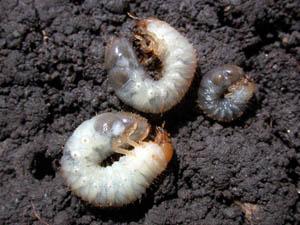In the ongoing struggle to control white grubs in golf course turf, research conducted at Purdue University indicates that granular and liquid formulations of some biological controls can be effective tools in a turfgrass manager's arsenal.
 Doug Richmond, Ph.D., associate professor of turfgrass entomology at Purdue, and Robert Behle, Ph.D., research entomologist with the U.S. Department of Agriculture, recently completed a three-year study showing that liquid or granular formulations of a common biological control were effective at killing Japanese beetles, June beetles, masked chafers throughout various life stages.
Doug Richmond, Ph.D., associate professor of turfgrass entomology at Purdue, and Robert Behle, Ph.D., research entomologist with the U.S. Department of Agriculture, recently completed a three-year study showing that liquid or granular formulations of a common biological control were effective at killing Japanese beetles, June beetles, masked chafers throughout various life stages.The researchers used a USDA method, known as liquid culture fermentation, to mass produce Metarhizium fungi and convert them into granular form that is applied to the soil. According to Richmond and Behle, liquid and granular formulations of Metarhizium fungi made with microsclerotia that are capable of producing infective conidia after application to the field can be more effective than commercial grade biologicals at controlling grubs depending on the life stage of the pest.
Beetles were collected at three stages of the lifecycle and placed in cups where they were exposed to varied rates of commercial grade biologicals, granules made from microsclerotia and imidacloprid.
Control of biological products ranged from 20 percent in the larval stage early in the season to almost 70 percent in third instar grubs in late summer or early fall. By comparison, imidacloprid controlled virtually all grubs in the larval stage, but control was similar to that shown by biological products at the third instar level.
The project, which was conducted on Kentucky bluegrass turf in West Lafayette, Indiana, was funded by a grant from the U.S. Golf Association.
Researchers were not recommending biologicals as a replacement for tools like imidacloprid, but rather as part of an integrated pest management plan.

